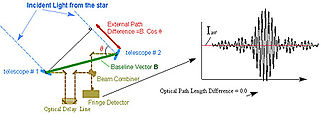
Astrometry is a branch of astronomy that involves precise measurements of the positions and movements of stars and other celestial bodies. It provides the kinematics and physical origin of the Solar System and our galaxy, the Milky Way.

A satellite or artificial satellite is an object intentionally placed into orbit in outer space. Except for passive satellites, most satellites have an electricity generation system for equipment on board, such as solar panels or radioisotope thermoelectric generators (RTGs). Most satellites also have a method of communication to ground stations, called transponders. Many satellites use a standardized bus to save cost and work, the most popular of which is small CubeSats. Similar satellites can work together as a group, forming constellations. Because of the high launch cost to space, satellites are designed to be as lightweight and robust as possible.

Satellite flare, also known as satellite glint, is a satellite pass visible to the naked eye as a brief, bright "flare". It is caused by the reflection toward the Earth below of sunlight incident on satellite surfaces such as solar panels and antennas. Streaks from satellite flare are a form of light pollution that can negatively impact ground-based astronomy, stargazing, and indigenous people.

Space advertising is advertising in space. There have been several proposals to advertise in space, with some even planning to launch billboards that would be visible from Earth. Space advertising may be obtrusive or non-obtrusive.
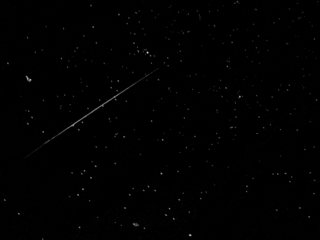
COSMO-SkyMed is an Earth-observation satellite space-based radar system funded by the Italian Ministry of Research and Ministry of Defence and conducted by the Italian Space Agency (ASI), intended for both military and civilian use. The prime contractor for the spacecraft was Thales Alenia Space. COSMO SkyMed is a constellation of four dual use Intelligence, surveillance, target acquisition, and reconnaissance (ISR) Earth observation satellites with a synthetic-aperture radar (SAR) as main payload, the result of the intuition of Giorgio Perrotta in the early nineties. The synthetic-aperture radar was developed starting in the late nineties with the SAR 2000 program funded by ASI.

Transiting Exoplanet Survey Satellite is a space telescope for NASA's Explorer program, designed to search for exoplanets using the transit method in an area 400 times larger than that covered by the Kepler mission. It was launched on 18 April 2018, atop a Falcon 9 launch vehicle and was placed into a highly elliptical 13.70-day orbit around the Earth. The first light image from TESS was taken on 7 August 2018, and released publicly on 17 September 2018.

The Iridium satellite constellation provides L band voice and data information coverage to satellite phones, pagers and integrated transceivers over the entire surface of Earth. Iridium Communications owns and operates the constellation, additionally selling equipment and access to its services. It was conceived by Bary Bertiger, Raymond J. Leopold and Ken Peterson in late 1987 and then developed by Motorola on a fixed-price contract from July 29, 1993, to November 1, 1998, when the system became operational and commercially available.
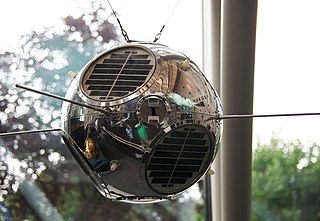
SOLRAD 4B was a solar X-ray, ultraviolet, and electronic surveillance satellite. Developed by the United States Navy's United States Naval Research Laboratory, it was the fifth in both the SOLRAD and the GRAB programs.

Rocket Lab is a public American aerospace manufacturer and launch service provider, with a New Zealand subsidiary. The company is currently operating lightweight Electron orbital rockets, providing dedicated launches for small satellites. Rocket Lab has also announced a plan to build a larger Neutron rocket, as early as 2024. Electron rockets have launched 26 times from either Rocket Lab's Launch Complex 1 or the Mid-Atlantic Regional Spaceport, and one has attempted a booster recovery. As of 2022, Rocket Lab is developing the bigger Neutron reusable unibody rocket, Photon satellite buses, and Rutherford, Curie, HyperCurie, Archimedes rocket engines. In the past, the company has worked on the Ātea sounding rocket, which has successfully launched once to space.

The history of X-ray astronomy begins in the 1920s, with interest in short wave communications for the U.S. Navy. This was soon followed by extensive study of the earth's ionosphere. By 1927, interest in the detection of X-ray and ultraviolet (UV) radiation at high altitudes inspired researchers to launch Goddard's rockets into the upper atmosphere to support theoretical studies and data gathering. The first successful rocket flight equipped with instrumentation able to detect solar ultraviolet radiation occurred in 1946. X-ray solar studies began in 1949. By 1973 a solar instrument package orbited on Skylab providing significant solar data.
SkySat is a constellation of sub-meter resolution Earth observation satellites owned by Planet Labs, providing imagery, high-definition video and analytics services. Planet acquired the satellites with their purchase of Terra Bella, a Mountain View, California-based company founded in 2009 by Dan Berkenstock, Julian Mann, John Fenwick, and Ching-Yu Hu, from Google in 2017.
Spaceflight Industries, Inc. is an American private aerospace company based out of Herndon, Virginia that specializes in geospatial intelligence services. It sold its satellite rideshare business, Spaceflight, Inc., in June 2020.

Planet Labs PBC is an American public Earth imaging company based in San Francisco, California. Their goal is to image the entirety of the Earth daily to monitor changes and pinpoint trends.
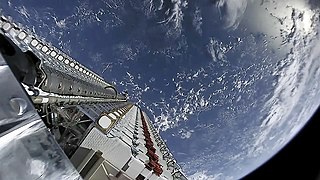
Starlink is a satellite internet constellation operated by SpaceX, providing satellite Internet access coverage to 39 countries. It aims for global coverage. SpaceX started launching Starlink satellites in 2019. As of July 2022, Starlink consists of over 3,000 mass-produced small satellites in low Earth orbit (LEO), which communicate with designated ground transceivers. Starlink provides internet access to over 500,000 subscribers as of June 2022.

This article documents notable and expected spaceflight events during the year 2022.
Curie is a liquid-propellant rocket engine designed and manufactured by Rocket Lab. A monopropellant is used for the propulsion of the third stage/kicker stage of the Electron rocket, as well as the Photon. The composition of the propellant is a trade secret.
Orbital Reflector is a reflective, mylar sculpture by Trevor Paglen launched into space as a temporary satellite. Co-produced by the Nevada Museum of Art, the $1.3 million project had the objective of being the first “purely artistic” object in space. The satellite, containing an inflatable mylar balloon with reflective surface, launched into space 3 December 2018.
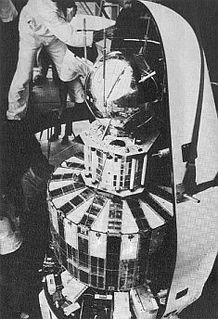
SOLRAD 3 was a solar X-ray satellite, the third in the SOLRAD program. Developed by the United States Navy's Naval Research Laboratory (USNRL), it shared satellite space with and provided cover for the Navy's GRAB 2, a secret electronic surveillance program.














